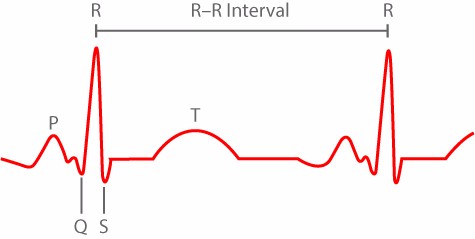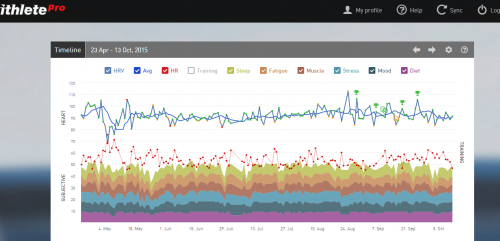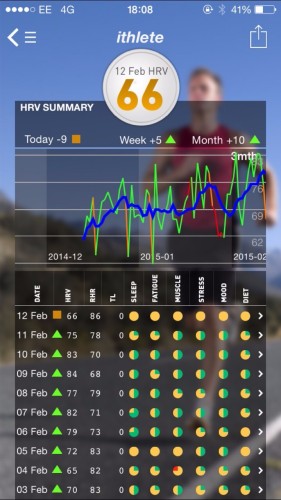Monitoring You, yourself and your responses
I started this post as a draft while traveling back from a training camp in Lanzarote last February, I’m actually quite surprised that by in large my HRV “thoughts” have stayed the same. Why? Well because I think the principles applying HRV data to how we monitor or adapt training have stayed the same. Principles I suppose are just that, pretty solid!
Having toyed with a longwinded, in-depth, referenced blog about the science, theory and application behind using a HRV monitoring system with your training. I’ve decided instead to keep it practical.
HRV or Heart rate variability is the time between the distinct beats of your heart, controlled or regulated by the vagal nerve, via one “side” – parasympathetic- of the bodies automatic control system or autonomic nervous system.

With the phone application based system we use (ithlete) it is the Root mean squared of the successive R-R intervals (gap between peaks) of your heartbeat that is used and this is the “metric” (read: measurement) used to give a window into the current state of activation of your Autonomic Nervous system (ANS).

If your body is stressed the sympathetic side of the ANS will be more prominent and will reduce HRV, that stress can be lifestyle related, travel, training, sickness or anything of the sort, if you are relaxed, rested and in good health then the para-sympathetic side of your ANS will be more prominent and this will show in your HRV reading. – In lay-mans terms this is “fight or flight” vs. “rest and digest”.
So by taking a Heart rate based reading each morning you can get a window into your health, fitness, readiness to train and overall well-being. By taking these readings consistently you can first set a baseline and then see trends, patterns and gain insight into what makes or creates success or failure in your own training, riding and lifestyle.
I’ve been using the ithlete HRV system for over 2 years now and many Point1 Athletes are also using it to monitor their daily training status but more importantly to fine tune sleep, lifestyle and other factors that affect adaptation to training and most importantly the ability to apply consistent training load.
What we’ve learned so far?
The how to: the ithlete system uses a 60 sec reading – unlike a hospital medical grade HRV reading of 5min +, but it doesn’t matter, it’s convenient and works exceptionally well (validated by numerous research papers). The key is to respect the process; do the job right! Basically stick to the same routine, take your readings each morning, similar time, standing or seated, consistent breathing pattern, no water or major activity before and a minimum of 2 minutes relaxation if not taking it as soon as you wake. As long as you stick to a repeatable and reliable routine the readings will consistent, relevant and useable in tracking and changing training.
Lifestyle matters: and matters a lot. Time and again lifestyle factors, like the food you eat, the rest you take between training and the quality of this rest, caffeine and alcohol intake, dance floor intervals until 4 a.m., bedtime routine. They all confound to make clear differences in not only your recovery from but your adaptation to training. Like I tell all of my athletes – Process is king! – If you don’t have the lifestyle factors on point you’ll never get on top of the gainz train and that is something we’ve seen time and again with athletes HRV readings. Travel to a race, long haul, trans-Atlantic, 9 time zone changes coupled with average food, mediocre hydration etc.. will always lead to a large drop in HRV. Likewise an athlete not really grasping the eat quality whole foods, rest well, make your easy rides EASY etc… does not see the same steady increase in HRV scores over a 6 week Aerobic focused training cycle as the lifestyle savvy, process focused athlete. In a nutshell monitoring HRV is scientific collection of data that gives a window into complex biological processes that are hugely affected by every decision we make….this means unavoidable accountability for the athlete. Actions = Outcomes. Cause & Effect!
Sleep has no equal: I always knew that sleep was a key “training process variable” but long term HRV monitoring of athletes and my own self drove this point home so hard that it is burnt into my mind as the first variable I consider when an athlete falls sick, complains of soreness, or doesn’t hit training targets. Poor quality sleep or less than 7+ hours, whether it’s because of caffeine, stress, poor environment or anything else will invariable lead to a lower HRV score. Some athletes will get away with 1 nights poor sleep, maybe two if all their other ducks are lined up but no-one and I mean no-one gets away with 3 in a row or more. Counting your winks is the biggest un-drummed variable in your health and performance! Simple training with, quality nutrition, adequate water and many hours of blissful sleep will get you so toward your goals it is scary! But I suppose it makes perfect sense as quality sleep restores the immune and endocrine systems and helps “repay” the metabolic cost of living and training!
Not all athletes are created equal: Some people are just more damn robust than others and robustness is something with many intangibles. But although some robustness factors are genetic, much of it comes, I feel, from 3 areas and I think my assumptions are in part clearly backed up by the HRV readings of my athletes. 1) aerobic endurance/capacity/capabilities – a complete, powerful aerobic metabolic foundation both peripherally and centrally will lead to a foundation of resilience not possible to garner through other means, 2) Strength, from joint health, connective tissue strength, elasticity and quality right through to force production potential and fibre type; large strength reserves time and again mean athletes recovery faster, adapted better and get less sore than their less strong peers, 3) experience; doing the right thing, in the right quantities at the right time! Not having to listen to coach to make a clever call on training durations, meals, or recovery modalities needed, the guy and girls with lateral thought capacity and a few years/decades experience under the belt time and again have less poor readings but more importantly can dial in a simple strategy to make the positive changes needed to head back to the GREEN!
Training mode: Certain training modes and means seem to affect HRV response more than others. Basic Strength training focused on muscle mass increase (hypertrophy), relative strength or strength maintenance as-well as some “special-strength” means have little effect in single bouts on HRV. Likewise moderate intensity cycling training leads to little changes in HRV in trained athletes when lifestyle factors are dialled.

What does effect HRV scores, first “negatively” – not necessarily a bad thing, is high intensity work, Extensive anaerobic type intervals, long days of Enduro type riding, “high intensity metabolic conditioning” in the gym etc.… will all, if carried out to correct intensity and in appropriate volume, lead to some major reductions in HRV. That is though the desired outcome, adequate stress to stimulate adaptation.
Next “positively” – moderate intensity aerobically focused, low impact type activities across a pretty wide bandwidth, promote, via processes not fully understood, improvements in HRV when used as regeneration during periods of more high intensity focused work or even during periods of increased non-training related stress. Again this is across a range and specific to individuals. But needless to say monitoring HRV has allowed us to fine tune regeneration modalities, volumes and planning for athletes. With abrupt cessations of training or post-race being swiftly replaced with moderate days of activity based on what HRV has told us.
The above situations are where HRV is used for day to day decision making into what training type is best or in our case at Point1 to help guide or totally change the planned training in a micro-cycle.
That is acute changes in light of the chronic rolling change in HRV, a key to using HRV in your training monitoring and decision making is Context. What is the minimum meaningful change in HRV in context of weekly, monthly and overall chronic change? What did we want, what did we get, why and how? Many aspects of these questions can be answered with better insight via smart use of HRV monitoring. Most certainly questions relating to aerobic characteristic fitness variables.
Mini-Case Study
Now while the exact mechanisms behind why improvements in aerobic fitness are reflected in HRV readings are not fully understood, there is some research out there that does a good job elucidating to the how behind it. With clarity in mind though, I thought it better to give you a more anecdotal account of how improvements in HRV score reflected real improvements in the lab and on the bike.
The below graph is from a Point1 athletes ithelte HRV dashboard. It shows over a 10 point increase in HRV scoring average over a one month period. It also shows “response” to training stimuli with the saw tooth profile of green and red daily scores. The blue trend line is climbing and that’s what I expected as coach given the training focus. Near the end of February the athlete in question returns to a laboratory for a Vo2 Max test amongst other tests.

The Results? – A 10% increase in Vo2 Max since testing in late 2014. An increase of 25w in 15sec MPO and a small increase in power at Lactate Threshold or OBLA and maybe most marked was the increase in power output at FatMax which gave the athlete a 40w growth in metabolic flexibility!
All of the above lab results showing marked improvements in central and peripheral adaptations to training.
All of the above reflected in a considerably higher baseline HRV.
What’s next?
Well I will certainly continue to use HRV monitoring with ithlete for daily training changes and longer term insight into training, racing and lifestyle factors that matter most to Point1 athletes.
Beyond that, some recent research highlighting the possibility of quantifying training load and the individual cost of training sessions using relative pre and post HRV scores may open up some new avenues for more HRV use. I’ll trial run those theories before they’ll ever get to Point1 athletes. But if we can quantify the metabolic cost of a particular session consistently and then compare identical sessions and an athlete’s response to those session given their current freshness or training readiness than we can really start to get a more quantifiable view into what truly affects preparedness for competition.
If Session 1 = 55 on a Stress-Score scale to 100 when you start a training cycle but the exact same session only gives you a “stress-score” of 25 after 5 weeks of training, than it may be wise to think that the athlete has adapted to that stimulus and will need more of it to garner any further benefit! At least that’s the sort of minute detail I think we can start to gain insight to via the use of HRV if the above principles and caveats are kept in mind.
That’s the key to HRV use, mindfulness, mindfulness in collection, interpretation and application of the data. It’s the easy application of the data being the most fulfilling aspect of using the ithelte system.
